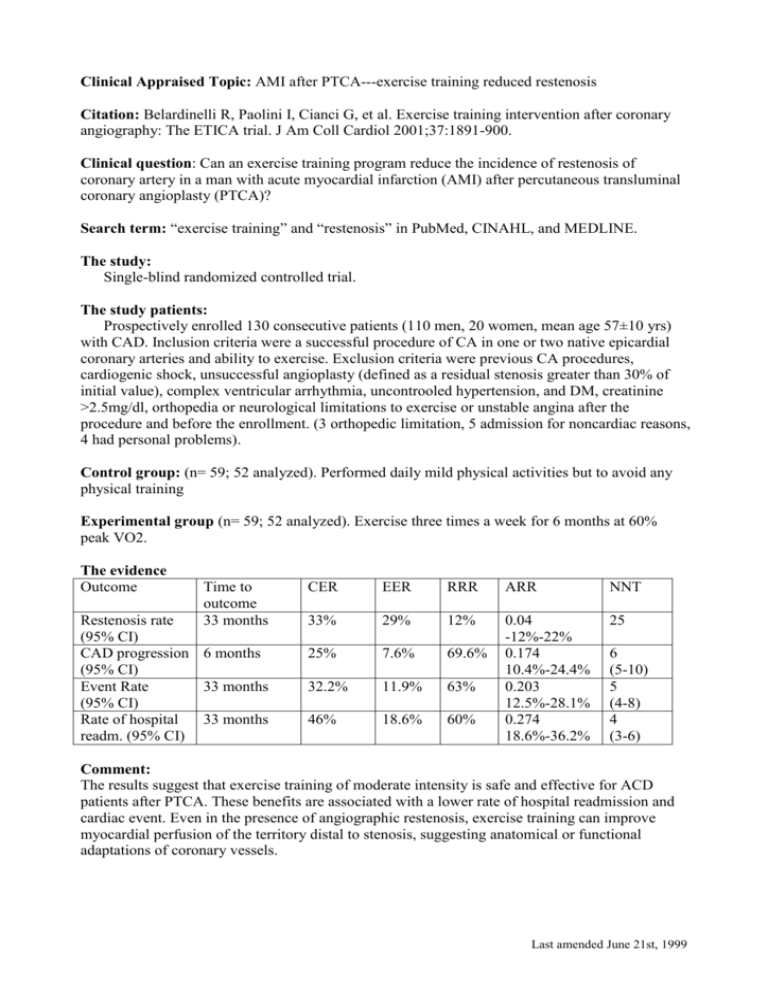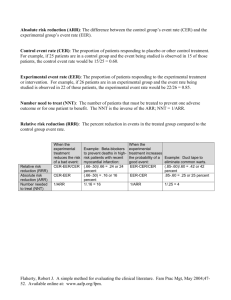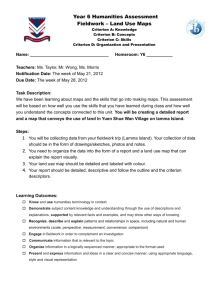THERAPY WORKSHEET: page 1 of 2
advertisement

Clinical Appraised Topic: AMI after PTCA---exercise training reduced restenosis Citation: Belardinelli R, Paolini I, Cianci G, et al. Exercise training intervention after coronary angiography: The ETICA trial. J Am Coll Cardiol 2001;37:1891-900. Clinical question: Can an exercise training program reduce the incidence of restenosis of coronary artery in a man with acute myocardial infarction (AMI) after percutaneous transluminal coronary angioplasty (PTCA)? Search term: “exercise training” and “restenosis” in PubMed, CINAHL, and MEDLINE. The study: Single-blind randomized controlled trial. The study patients: Prospectively enrolled 130 consecutive patients (110 men, 20 women, mean age 57±10 yrs) with CAD. Inclusion criteria were a successful procedure of CA in one or two native epicardial coronary arteries and ability to exercise. Exclusion criteria were previous CA procedures, cardiogenic shock, unsuccessful angioplasty (defined as a residual stenosis greater than 30% of initial value), complex ventricular arrhythmia, uncontrooled hypertension, and DM, creatinine >2.5mg/dl, orthopedia or neurological limitations to exercise or unstable angina after the procedure and before the enrollment. (3 orthopedic limitation, 5 admission for noncardiac reasons, 4 had personal problems). Control group: (n= 59; 52 analyzed). Performed daily mild physical activities but to avoid any physical training Experimental group (n= 59; 52 analyzed). Exercise three times a week for 6 months at 60% peak VO2. The evidence Outcome Time to outcome 33 months Restenosis rate (95% CI) CAD progression 6 months (95% CI) Event Rate 33 months (95% CI) Rate of hospital 33 months readm. (95% CI) CER EER RRR ARR NNT 33% 29% 12% 25 25% 7.6% 69.6% 32.2% 11.9% 63% 46% 18.6% 60% 0.04 -12%-22% 0.174 10.4%-24.4% 0.203 12.5%-28.1% 0.274 18.6%-36.2% 6 (5-10) 5 (4-8) 4 (3-6) Comment: The results suggest that exercise training of moderate intensity is safe and effective for ACD patients after PTCA. These benefits are associated with a lower rate of hospital readmission and cardiac event. Even in the presence of angiographic restenosis, exercise training can improve myocardial perfusion of the territory distal to stenosis, suggesting anatomical or functional adaptations of coronary vessels. Last amended June 21st, 1999 THERAPY WORKSHEET: page 1 of 2 Sackett Corrected 2 Dec 1996 Citation: Are the results of this single preventive or therapeutic trial valid? Was the assignment of patients to treatments + randomised? -and was the randomisation list concealed? Were all patients who entered the trial accounted for at its conclusion? -and were they analysed in the groups to which they were randomised? Were patients and clinicians kept “blind” + (clinician)/- (patient) to which treatment was being received? Aside from the experimental treatment, + were the groups treated equally? Were the groups similar at the start of the ? (did not describe in text) trial? Are the valid results of this randomised trial important? SAMPLE CALCULATIONS: Occurrence of diabetic Relative Risk neuropathy Reduction RRR Usual Insulin Intensive CER - EER Control Event Insulin CER Rate Experimental CER Event Rate EER 9.6% 2.8% 9.6% - 2.8% 71% 9.6% = Absolute Risk Reduction ARR CER - EER Number Needed to Treat NNT 1/ARR 9.6% - 2.8% = 6.8% (4.3% to 9.3%) 1/6.8% = 15 pts, (11 to 23) 95% Confidence Interval (CI) on an NNT = 1 / (limits on the CI of its ARR) = YOUR CALCULATIONS: CER EER Relative Risk Reduction RRR CER - EER CER Absolute Risk Reduction ARR CER - EER Number Needed to Treat NNT 1/ARR Last amended June 21st, 1999 THERAPY WORKSHEET: page 2 of 2 Can you apply this valid, important evidence about a treatment in caring for your patient? Do these results apply to your patient? Is your patient so different from those in the trial that its results can’t help you? How great would the potential benefit of therapy actually be for your individual patient? Method I: f Method II: 1 / (PEER x RRR) Risk of the outcome in your patient, relative to patients in the trial. expressed as a decimal: ______ NNT/F = _____/_____ = _________ (NNT for patients like yours) Your patient’s expected event rate if they received the control treatment: PEER:40%*12% (restenosis), 40%*69.6% (CAD progression) 1 / (PEER x RRR) = 1/4.8% or 1/27.84% = 21 or 4 (NNT for patients like yours) Are your patient’s values and preferences satisfied by the regimen and its consequences? + Do your patient and you have a clear assessment of their values and preferences? Are they met by this regimen and its consequences? + Additional Notes: Last amended June 21st, 1999 PEDro Scale 1. eligibility criteria were specified no yes ▉ where: 2. subjects were randomly allocated to groups (in a crossover study, subjects were randomly allocated an order in which treatments were received) no yes ▉ where: 3. allocation was concealed no ▉ yes where: 4. the groups were similar at baseline regarding the most important prognostic indicators no yes ▉ where: 5. there was blinding of all subjects no ▉ yes where: 6. there was blinding of all therapists who administered the therapy no ▉ yes where: 7. there was blinding of all assessors who measured at least one key outcome no yes ▉ where: 8. measures of at least one key outcome were obtained from more than 85% of the subjects initially allocated to groups no yes ▉ where: 9. all subjects for whom outcome measures were available received the treatment or control condition as allocated or, where this was not the case, data for at least one key outcome was analysed by “intention to treat” no ▉ yes where: 10. the results of between-group statistical comparisons are reported for at least one key outcome no yes ▉ where: 11. the study provides both point measures and measures of variability for at least one key outcome no yes ▉ where: The PEDro scale is based on the Delphi list developed by Verhagen and colleagues at the Department of Epidemiology, University of Maastricht (Verhagen AP et al (1998). The Delphi list: a criteria list for quality assessment of randomised clinical trials for conducting systematic reviews developed by Delphi consensus. Journal of Clinical Epidemiology, 51(12):1235-41). The list is based on "expert consensus" not, for the most part, on empirical data. Two additional items not on the Delphi list (PEDro scale items 8 and 10) have been included in the PEDro scale. As more empirical data comes to hand it may become possible to "weight" scale items so that the PEDro score reflects the importance of individual scale items. The purpose of the PEDro scale is to help the users of the PEDro database rapidly identify which of the known or suspected randomised clinical trials (ie RCTs or CCTs) archived on the PEDro database are likely to be internally valid (criteria 2-9), and could have sufficient statistical information to make their results interpretable (criteria 10-11). An additional criterion (criterion 1) that relates to the external validity (or “generalisability” or “applicability” of the trial) has been retained so that the Delphi list is complete, but this criterion will not be used to calculate the PEDro score reported on the PEDro web site. The PEDro scale should not be used as a measure of the “validity” of a study’s conclusions. In particular, we caution users of the PEDro scale that studies which show significant treatment effects and which score highly on the PEDro scale do not necessarily provide evidence that the treatment is clinically useful. Additional considerations include whether the treatment effect was big enough to be clinically worthwhile, whether the positive effects of the treatment outweigh its negative effects, and the cost-effectiveness of the treatment. The scale should not be used to compare the "quality" of trials performed in different areas of therapy, primarily because it is not possible to satisfy all scale items in some areas of physiotherapy practice. Last amended June 21st, 1999 Notes on administration of the PEDro scale: All criteria Points are only awarded when a criterion is clearly satisfied. If on a literal reading of the trial report it is possible that a criterion was not satisfied, a point should not be awarded for that criterion. Criterion 1 This criterion is satisfied if the report describes the source of subjects and a list of criteria used to determine who was eligible to participate in the study. Criterion 2 A study is considered to have used random allocation if the report states that allocation was random. The precise method of randomisation need not be specified. Procedures such as coin-tossing and dice-rolling should be considered random. Quasi-randomisation allocation procedures such as allocation by hospital record number or birth date, or alternation, do not satisfy this criterion. Criterion 3 Concealed allocation means that the person who determined if a subject was eligible for inclusion in the trial was unaware, when this decision was made, of which group the subject would be allocated to. A point is awarded for this criteria, even if it is not stated that allocation was concealed, when the report states that allocation was by sealed opaque envelopes or that allocation involved contacting the holder of the allocation schedule who was “off-site”. Criterion 4 At a minimum, in studies of therapeutic interventions, the report must describe at least one measure of the severity of the condition being treated and at least one (different) key outcome measure at baseline. The rater must be satisfied that the groups’ outcomes would not be expected to differ, on the basis of baseline differences in prognostic variables alone, by a clinically significant amount. This criterion is satisfied even if only baseline data of study completers are presented. Criteria 4, 7-11 Key outcomes are those outcomes which provide the primary measure of the effectiveness (or lack of effectiveness) of the therapy. In most studies, more than one variable is used as an outcome measure. Criterion 5-7 Blinding means the person in question (subject, therapist or assessor) did not know which group the subject had been allocated to. In addition, subjects and therapists are only considered to be “blind” if it could be expected that they would have been unable to distinguish between the treatments applied to different groups. In trials in which key outcomes are self-reported (eg, visual analogue scale, pain diary), the assessor is considered to be blind if the subject was blind. Criterion 8 This criterion is only satisfied if the report explicitly states both the number of subjects initially allocated to groups and the number of subjects from whom key outcome measures were obtained. In trials in which outcomes are measured at several points in time, a key outcome must have been measured in more than 85% of subjects at one of those points in time. Criterion 9 An intention to treat analysis means that, where subjects did not receive treatment (or the control condition) as allocated, and where measures of outcomes were available, the analysis was performed as if subjects received the treatment (or control condition) they were allocated to. This criterion is satisfied, even if there is no mention of analysis by intention to treat, if the report explicitly states that all subjects received treatment or control conditions as allocated. Criterion 10 A between-group statistical comparison involves statistical comparison of one group with another. Depending on the design of the study, this may involve comparison of two or more treatments, or comparison of treatment with a control condition. The analysis may be a simple comparison of outcomes measured after the treatment was administered, or a comparison of the change in one group with the change in another (when a factorial analysis of variance has been used to analyse the data, the latter is often reported as a group time interaction). The comparison may be in the form hypothesis testing (which provides a “p” value, describing the probability that the groups differed only by chance) or in the form of an estimate (for example, the mean or median difference, or a difference in proportions, or number needed to treat, or a relative risk or hazard ratio) and its confidence interval. Last amended June 21st, 1999 Criterion 11 A point measure is a measure of the size of the treatment effect. The treatment effect may be described as a difference in group outcomes, or as the outcome in (each of) all groups. Measures of variability include standard deviations, standard errors, confidence intervals, interquartile ranges (or other quantile ranges), and ranges. Point measures and/or measures of variability may be provided graphically (for example, SDs may be given as error bars in a Figure) as long as it is clear what is being graphed (for example, as long as it is clear whether error bars represent SDs or SEs). Where outcomes are categorical, this criterion is considered to have been met if the number of subjects in each category is given for each group. Last amended June 21st, 1999






